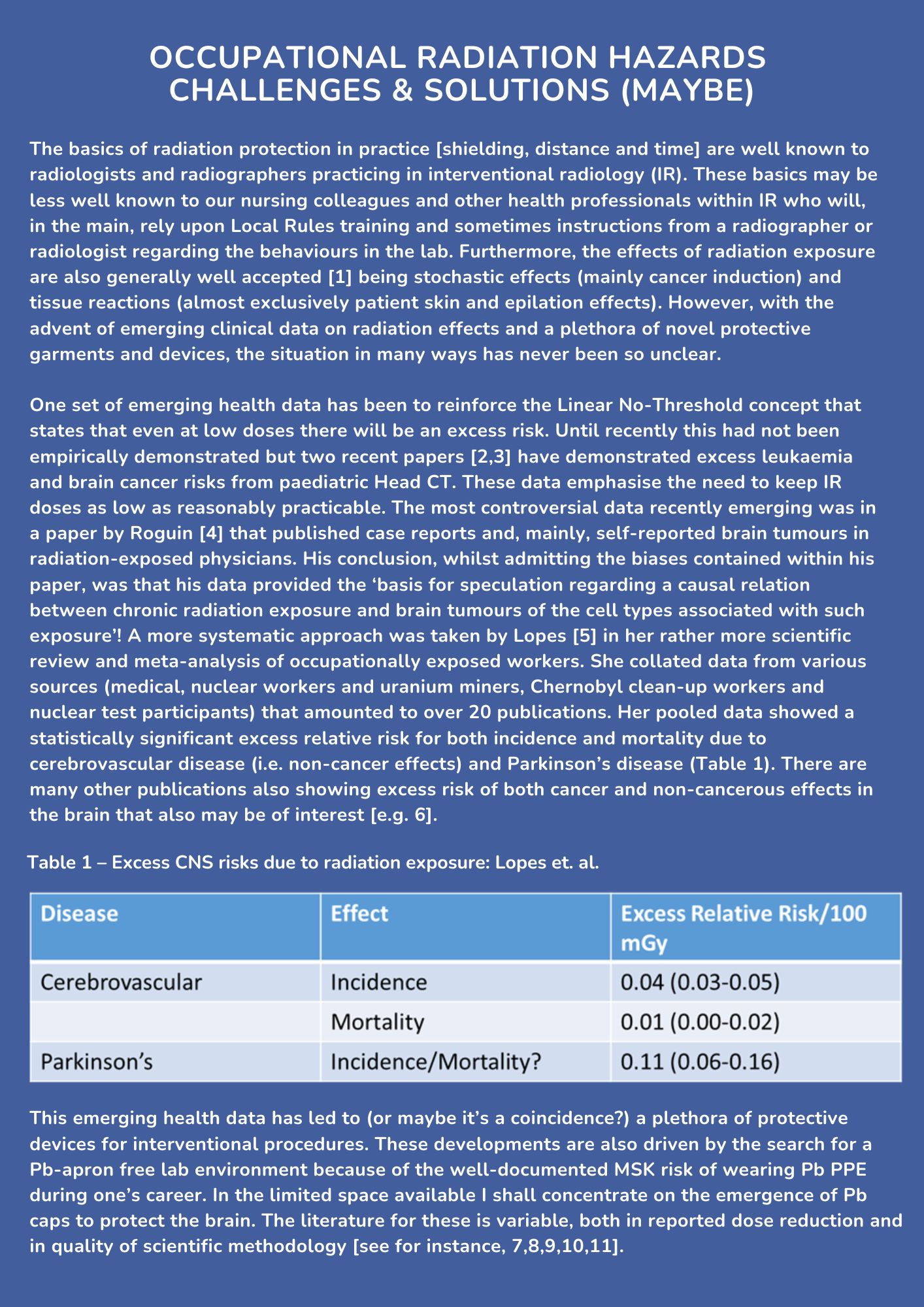
4 minute read
OCCUPATIONAL RADIATION HAZARDS CHALLENGES & SOLUTIONS (MAYBE)
by BSIR
The basics of radiation protection in practice [shielding, distance and time] are well known to radiologists and radiographers practicing in interventional radiology (IR). These basics may be less well known to our nursing colleagues and other health professionals within IR who will, in the main, rely upon Local Rules training and sometimes instructions from a radiographer or radiologist regarding the behaviours in the lab. Furthermore, the effects of radiation exposure are also generally well accepted [1] being stochastic effects (mainly cancer induction) and tissue reactions (almost exclusively patient skin and epilation effects). However, with the advent of emerging clinical data on radiation effects and a plethora of novel protective garments and devices, the situation in many ways has never been so unclear.
One set of emerging health data has been to reinforce the Linear No-Threshold concept that states that even at low doses there will be an excess risk. Until recently this had not been empirically demonstrated but two recent papers [2,3] have demonstrated excess leukaemia and brain cancer risks from paediatric Head CT. These data emphasise the need to keep IR doses as low as reasonably practicable. The most controversial data recently emerging was in a paper by Roguin [4] that published case reports and, mainly, self-reported brain tumours in radiation-exposed physicians. His conclusion, whilst admitting the biases contained within his paper, was that his data provided the ‘basis for speculation regarding a causal relation between chronic radiation exposure and brain tumours of the cell types associated with such exposure’! A more systematic approach was taken by Lopes [5] in her rather more scientific review and meta-analysis of occupationally exposed workers. She collated data from various sources (medical, nuclear workers and uranium miners, Chernobyl clean-up workers and nuclear test participants) that amounted to over 20 publications. Her pooled data showed a statistically significant excess relative risk for both incidence and mortality due to cerebrovascular disease (i.e. non-cancer effects) and Parkinson’s disease (Table 1). There are many other publications also showing excess risk of both cancer and non-cancerous effects in the brain that also may be of interest [e.g. 6].
This emerging health data has led to (or maybe it’s a coincidence?) a plethora of protective devices for interventional procedures. These developments are also driven by the search for a Pb-apron free lab environment because of the well-documented MSK risk of wearing Pb PPE during one’s career. In the limited space available I shall concentrate on the emergence of Pb caps to protect the brain. The literature for these is variable, both in reported dose reduction and in quality of scientific methodology [see for instance, 7,8,9,10,11].
The difficulty with many of these papers is that they do not estimate brain dose The doses reported by some of these works report results from passive dosimeters placed on the inside and outside of various devices and therefore is measuring the device attenuation directly rather than a brain dose protective effect This is borne out by Figure 1 from Ramos-Avasola et al [10]

This all goes to show that we really don’t yet know with any degree of confidence what to do but if you do want to reduce brain dose then you require a Pb-hood as a significant element of brain dose comes from radiation entering the head from the front and lower LHS and then being scattered upwards into the brain
In summary, this is most definitely a live field for emerging data/evidence and my best advice at present would be to properly utilise a good ceiling suspended shield of 2mm Pb-equivalence and minimise patient dose as the less the patient gets, the less you get!



Read the full article: https://issuu.com/bsir/docs/2024_autumn_newsletter_3_
Andy Rogers
Lead Interventional Medical Physics Expert, Nottingham University Hospitals NHS Trust










